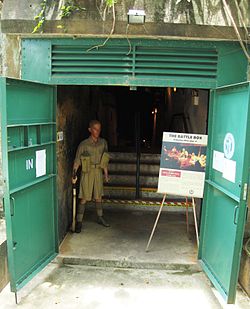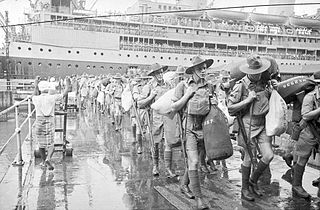
The 8th Division was an infantry division of the Australian Army, formed during World War II as part of the all-volunteer Second Australian Imperial Force. The 8th Division was raised from volunteers for overseas service from July 1940 onwards. Consisting of three infantry brigades, the intention had been to deploy the division to the Middle East to join the other Australian divisions, but as war with Japan loomed in 1941, the division was divided into four separate forces, which were deployed in different parts of the Asia-Pacific region. All of these formations were destroyed as fighting forces by the end of February 1942 during the fighting for Singapore, and in Rabaul, Ambon, and Timor. Most members of the division became prisoners of war, waiting until the war ended in late 1945 to be liberated. One in three died in captivity.
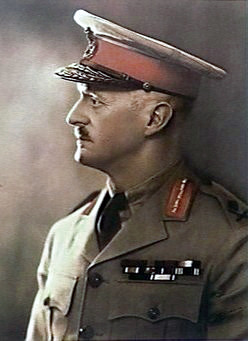
Lieutenant General Henry Gordon Bennett, was a senior Australian Army officer who served in both World War I and World War II. Despite highly decorated achievements during World War I, during which he commanded at both battalion and brigade level and became the youngest general in the Australian Army, Bennett is best remembered for his role during the fall of Singapore in February 1942. As commander of the 8th Australian Division, he escaped while his men became prisoners of the Imperial Japanese Army. After this, Bennett's military career waned and, although he rose to command a corps, he never again commanded troops in battle. In 1945, his escape caused controversy and resulted in a Royal Commission and military enquiry. Both found that he had been unjustified in relinquishing his command.

The South-East Asian Theatre of World War II consisted of the campaigns of the Pacific War in the Philippines, Thailand, Indonesia, Indochina, Burma, India, Malaya and Singapore between 1941 and 1945.
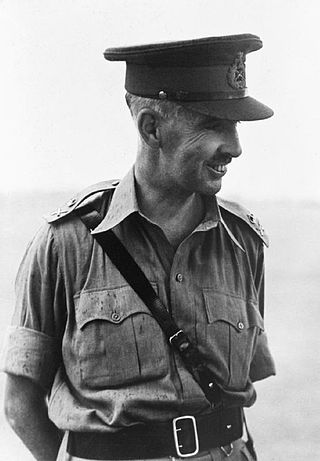
Lieutenant-General Arthur Ernest Percival, was a senior British Army officer. He saw service in the First World War and built a successful military career during the interwar period but is most noted for his defeat in the Second World War, when he commanded British Empire forces during the Japanese Malayan Campaign and the subsequent Battle of Singapore.
The Far East Command was a British military command which had 2 distinct periods. These were firstly, 18 November 1940 – 7 January 1942 succeeded by the American-British-Dutch-Australian Command (ABDACOM), and secondly, 1963–1971 succeeded by Australia, New Zealand, and United Kingdom Force

The fall of Singapore, also known as the Battle of Singapore, took place in the South–East Asian theatre of the Pacific War. The Japanese Empire captured the British stronghold of Singapore, with fighting lasting from 8 to 15 February 1942. Singapore was the foremost British military base and economic port in South–East Asia and had been of great importance to British interwar defence strategy. The capture of Singapore resulted in the largest British surrender in its history.

The Malayan campaign, referred to by Japanese sources as the Malay Operation, was a military campaign fought by Allied and Axis forces in Malaya, from 8 December 1941 – 15 February 1942 during the Second World War. It was dominated by land battles between British Commonwealth army units and the Imperial Japanese Army, with minor skirmishes at the beginning of the campaign between British Commonwealth and Royal Thai Police. The Japanese had air and naval supremacy from the opening days of the campaign. For the British, Indian, Australian, and Malayan forces defending the colony, the campaign was a total disaster.

Syonan, officially Syonan Island, was the name for Singapore when it was occupied and ruled by the Empire of Japan, following the fall and surrender of British military forces on 15 February 1942 during World War II.

Fort Canning Hill, formerly Government Hill, Singapore Hill and Bukit Larangan, or simply known as Fort Canning, is a prominent hill, about 48 metres (157 ft) high, in the southeast portion of Singapore, within the Central Area that forms Singapore's central business district.

The 1st Malaya Infantry Brigade was a regular infantry brigade formed in 1939 with its headquarters in Singapore immediately after the outbreak of hostilities in Europe. The Brigade participated in the Battle of Singapore against the Japanese until the surrender of the garrison in February 1942.
Brigadier Archibald Charles Melvill Paris, was a British Army officer.
Dalforce, officially the Singapore Overseas Chinese Anti-Japanese Volunteer Army was an irregular forces/guerrilla unit within the British Straits Settlements Volunteer Force during World War II. Its members were recruited among the ethnic Chinese people of Singapore. It was created on 25 December 1941 by Lieutenant Colonel John Dalley of the Federated Malay States Police Force. The unit was known to the British colonial administration as Dalforce, after its chief instructor and commanding officer, John Dalley, whereas the Chinese in Singapore only knew it as the Singapore Overseas Chinese Anti-Japanese Volunteer Army. This formation took part in the Battle of Singapore and some members conducted a guerrilla campaign against Japanese forces during the Japanese occupation. The British noted how ferociously the Chinese volunteers in Dalforce fought, earning them the nickname Dalley's Desperadoes.
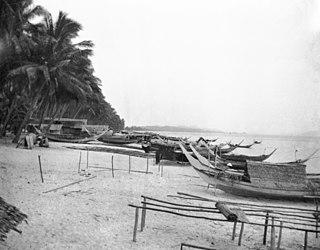
The Battle of Kota Bharu began just after midnight on 8 December 1941 before the attack on Pearl Harbor. It was the first major battle of the Pacific War, and was fought between ground forces of the British Indian Army and the Empire of Japan.

The Bukit Batok Memorial is located on top of the tranquil Bukit Batok Hill upon which once stood two war memorials built by Australian POWs to commemorate the war dead of the Japanese and the Allies who fought during the decisive Battle of Bukit Timah in Singapore during the Second World War. The two memorials were destroyed after the war and only the road and stairs that used to lead to them mark its legacy today.

Fort Pasir Panjang or Labrador Battery is located within Labrador Park at the southern tip of Singapore island. It was one of the 11 coastal artillery forts built by the British in the 19th century to defend the western passageway into Keppel Harbour against piracy and foreign naval powers. During the 1942 Battle of Pasir Panjang, the fort played a supporting role but a limited one in defending the Malay Regiments against the Japanese invasion at Bukit Chandu. In 1995, the site was gazetted by the National Heritage Board as one of the 11 World War II sites in Singapore.
The Farrer Park address was an assembly of the surrendered Indian troops of the British Indian Army held at Farrer Park in Singapore on 17 February 1942, two days after the Fall of Singapore. The assembly was marked by a series of three addresses in which the British Malaya Command formally surrendered the Indian troops of the British Indian Army to Major Fujiwara Iwaichi representing the Japanese military authority, followed by transfer of authority by Fujiwara to the command of Mohan Singh, and a subsequent address by Mohan Singh to the gathered troops declaring the formation of the Indian National Army to fight the Raj, asking for volunteers to join the army.

The Battle of Kranji was the second stage of the Empire of Japan's plan for the invasion of Singapore during the Second World War. On 9 February 1942 the Imperial Japanese Army assaulted the north-western front of Singapore, capital of the Straits Settlements.
The 27th Brigade was a brigade-sized infantry unit of the Australian Army. The brigade was the last Second Australian Imperial Force infantry brigade raised for service during World War II. Initially assigned to the 9th Division, the brigade was transferred to the 8th Division shortly after it was raised. Training was undertaken around Bathurst, New South Wales throughout early 1941, before the brigade was sent to British Malaya in August 1941 to reinforce the 22nd Brigade, which had been dispatched earlier in the year. Following the Japanese invasion of Malaya, the brigade went into action in January 1942, taking part in the fighting along the western side of the Malay Peninsula. Its main action during this period came around Muar before the withdrawal to Singapore. In February, the brigade took part in the short lived Battle of Singapore. When the garrison surrendered on 15 February, the majority of the brigade's personnel were taken prisoner. They subsequently spent the remainder of the war in captivity before being released in August 1945.
The 2nd Malaya Infantry Brigade was a regular infantry brigade formed in 1940 with its headquarters in Singapore following the wartime expansion and reinforcement of Malaya Command. The Brigade participated in the Malayan Campaign and the Battle of Singapore against the Japanese until the surrender of the garrison in February 1942.
The Former Command House is a historic building, located at Kheam Hock Road in Singapore. It was the residence of the General Officer Commanding (GOC) of Malaya during British colonial period.
